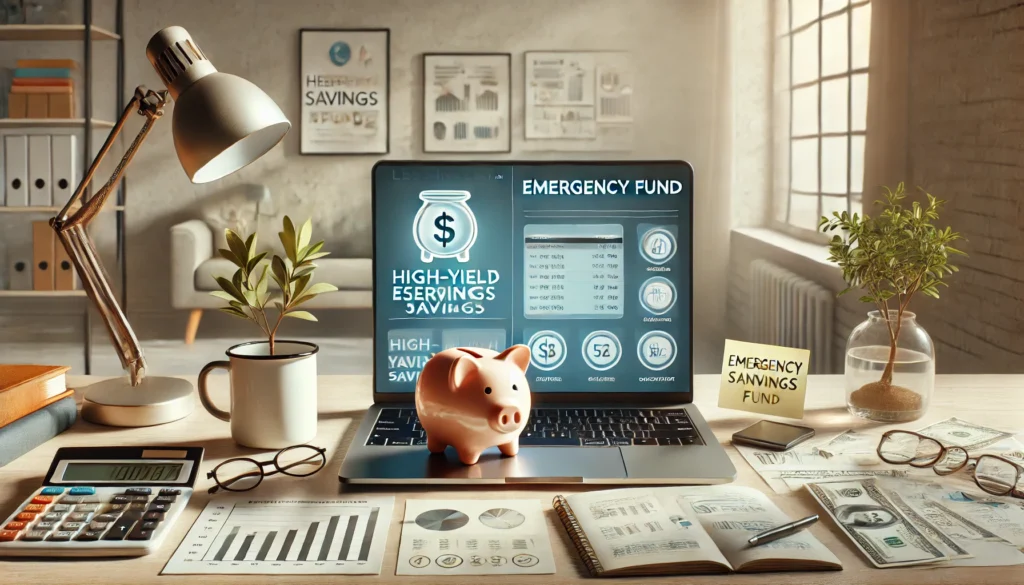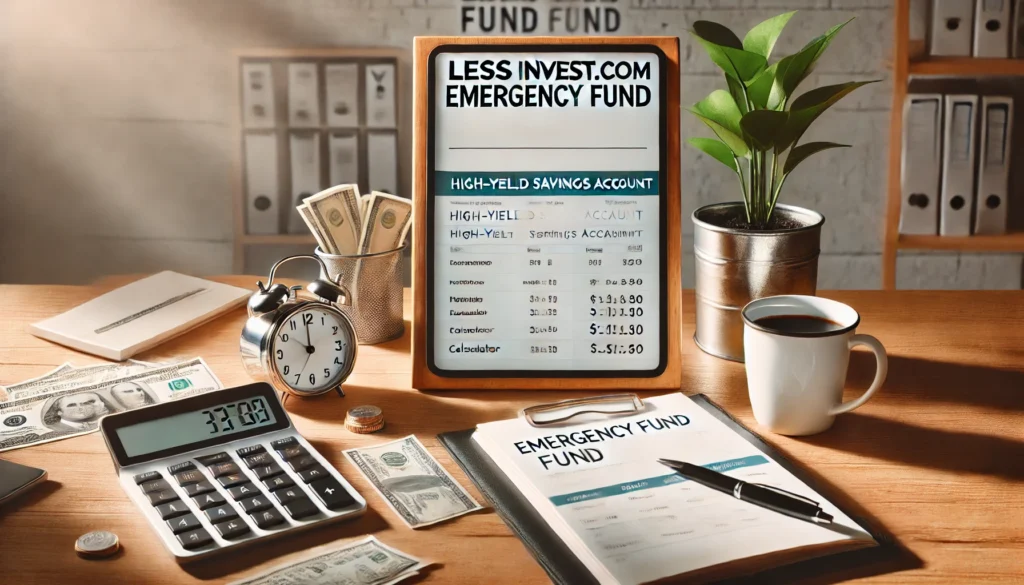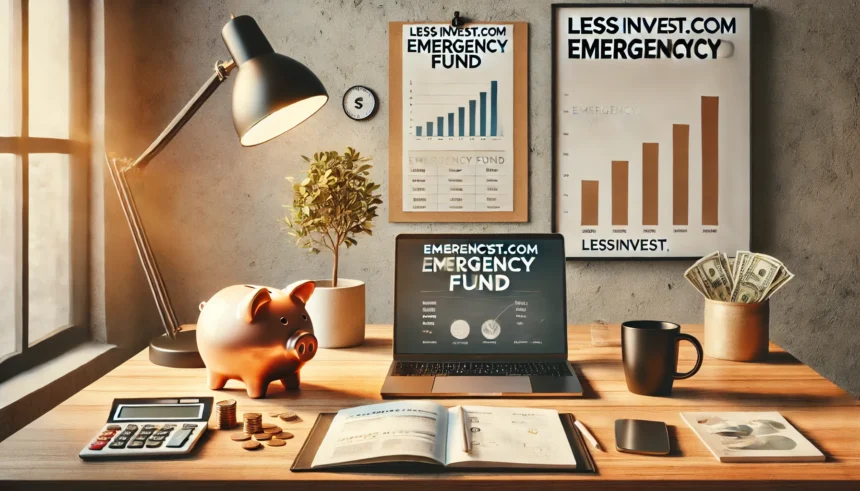An emergency fund is an essential component of a healthy financial plan. It is a safety net that helps you manage unexpected expenses, such as medical bills, car repairs, or even job loss. Without one, you might find yourself relying on credit cards or loans, which can create long-term financial stress. The LessInvest.com emergency fund provides simple, easy-to-understand guidance for building and managing your savings. In this article, we’ll walk you through the importance of an emergency fund, how much to save, where to store your savings, and how to overcome common challenges.
What is an Emergency Fund and Why Do You Need One?
An emergency fund is essentially a savings buffer for the unexpected. It’s designed to cover unplanned expenses without disrupting your regular financial goals or forcing you into debt. Whether you face a medical emergency, your car breaks down, or you lose your job, an emergency fund provides financial security in times of crisis.
Why is it Important?
- Avoid Debt: With an emergency fund, you won’t have to rely on high-interest debt, such as credit cards, to cover unexpected costs.
- Peace of Mind: Knowing that you’re financially prepared for the unexpected can significantly reduce stress and anxiety.
- Protect Your Long-Term Goals: Your emergency fund prevents you from dipping into retirement savings, investment accounts, or other long-term funds when something unexpected happens.
Ultimately, having an emergency fund is a proactive way to safeguard your financial health and maintain control during uncertain times.
Introduction to LessInvest.com
LessInvest.com is a financial resource platform that provides clear, easy-to-follow advice on everything from budgeting to saving and investing. The site offers tailored guidance to help you create an emergency fund and manage it effectively. Whether you are just getting started or looking to fine-tune your approach, LessInvest.com has the tools and information you need.
Why LessInvest.com?
- Personalized Tools: LessInvest.com offers helpful calculators and budgeting tools to ensure that your emergency fund meets your needs.
- Step-by-Step Guidance: The platform breaks down complex financial concepts into simple, actionable steps that anyone can follow.
- Comprehensive Learning: From understanding emergency funds to exploring long-term financial planning, LessInvest.com provides valuable educational resources to improve your overall financial literacy.
How Much Should You Save for an Emergency Fund?
A common recommendation is to save 3 to 6 months of living expenses in your emergency fund. This amount should be enough to cover essential costs such as rent or mortgage payments, utilities, groceries, and insurance premiums in case of job loss or other significant disruptions.
Factors That Affect the Amount You Need:
- Income Stability: If you have a steady job or source of income, you may be able to aim for the lower end of this range. However, if your income is inconsistent, you may want to save a larger cushion.
- Family Size: More dependents generally mean higher monthly expenses. If you support children or elderly relatives, your emergency fund should reflect that.
- Health and Job Market Risks: If you work in a volatile industry or have ongoing health concerns, it’s wise to lean towards the higher end of the 3-6 month recommendation.
LessInvest.com helps you determine the exact amount to save by taking these factors into account. The platform’s calculators allow you to input your expenses and income to create a personalized savings target.
Steps to Build Your Emergency Fund
Building an emergency fund doesn’t happen overnight, but it’s achievable with consistent effort. Below are the steps to start building your fund, provided by LessInvest.com.
Set Your Savings Goal
First, determine how much you need to save based on your living expenses and personal circumstances. A good starting point might be saving $1,000 for smaller emergencies, then gradually working up to 3–6 months of living expenses.
Create a Budget
Track your income and expenses to see where your money is going. LessInvest.com offers a simple budgeting tool to help you categorize your spending and identify areas where you can cut back. Consider reducing discretionary spending on things like eating out, entertainment, or subscriptions that you don’t need. Reallocate those savings to your emergency fund.
Automate Your Savings
To ensure that you are consistently contributing to your emergency fund, set up automatic transfers from your checking account to your savings account. Even small, regular transfers will add up over time.
Reduce Non-Essential Expenses
Look for areas to reduce your spending. For example, you can cancel unused subscriptions, cut back on entertainment costs, or find cheaper alternatives for your regular purchases. Direct the money you save from these areas straight into your emergency fund.
Increase Your Income
If possible, explore ways to boost your income, such as taking on a part-time job, freelance work, or starting a side business. Extra income should be directed toward your emergency fund until you reach your goal.
By breaking down your savings goal into smaller, manageable steps, you can stay motivated and on track.
Where Should You Keep Your Emergency Fund?
The account you choose for your emergency fund is crucial. You want a balance between accessibility, security, and some growth potential.
Best Types of Accounts for an Emergency Fund:
- High-Yield Savings Accounts: These accounts offer higher interest rates than regular savings accounts, allowing your money to grow while remaining easily accessible.
- Money Market Accounts: These accounts typically provide higher interest rates and come with limited check-writing privileges, allowing easy access to your funds.
- Short-Term Certificates of Deposit (CDs): If you’re comfortable locking away some of your emergency fund for a short period, a CD can earn you a higher interest rate, though you may face penalties for early withdrawal.
Remember, your emergency fund needs to be easily accessible in times of need, so avoid placing it in accounts that are difficult to access, such as long-term investments.
Overcoming Challenges in Saving for an Emergency Fund
Saving for an emergency fund can feel overwhelming, but with a solid plan, you can overcome these challenges.
Common Challenges:
- Living Paycheck to Paycheck: If you’re struggling to save, start small. Even putting aside $10 a week will add up over time. You can gradually increase the amount as your financial situation improves.
- Temptation to Spend: It’s easy to dip into your emergency fund for non-emergencies, but avoid doing this. Set clear boundaries for when the fund should be used and commit to rebuilding it afterward.
- Unexpected Expenses During Saving: Life is unpredictable. If you face an emergency while saving, prioritize replenishing your fund as soon as possible once the immediate crisis is over.
LessInvest.com provides helpful tips to stay disciplined in your savings habits and prioritize building your fund despite these challenges.
When and How to Use Your Emergency Fund
Your emergency fund is for genuine emergencies only. Here are some examples of situations where it’s appropriate to use your fund:
- Medical Bills or Health Emergencies
- Job Loss or Income Reduction
- Car Repairs or Home Maintenance Issues
Avoid using your emergency fund for vacations, shopping, or non-urgent expenses. When you do use it, make sure to replenish the amount you’ve spent as soon as possible.
The Benefits of Having an Emergency Fund
Once you have built an emergency fund, you will enjoy several key benefits:
- Financial Security: You won’t have to rely on credit cards or loans during tough times.
- Peace of Mind: You’ll feel more confident knowing you can handle life’s unexpected events without financial stress.
- Better Financial Discipline: The habit of saving regularly will help you with all aspects of your financial life, including saving for retirement and paying down debt.
Additional Resources from LessInvest.com
In addition to the emergency fund guidance, LessInvest.com offers a variety of helpful tools and resources:
- Savings Calculators: These help you set realistic goals and track your progress.
- Educational Articles: Learn more about budgeting, saving, investing, and managing debt.
- Personalized Advice: Get insights tailored to your specific financial situation.
Conclusion
Building an emergency fund is an important step toward achieving financial stability and peace of mind. With the help of the LessInvest.com emergency fund guide, you can easily create and maintain a savings plan that fits your needs. By setting a realistic savings goal, budgeting effectively, and automating your savings, you can prepare for life’s uncertainties and protect your financial future. Start today, and take control of your finances with confidence.
FAQs
You should aim to save 3-6 months’ worth of essential living expenses, but adjust the amount based on income stability and family size.
Can I use my emergency fund for non-urgent expenses?
Your emergency fund is for unforeseen expenses like medical bills or job loss; avoid using it for routine or planned expenses.
Where should I keep my emergency fund?
It’s best to keep your emergency fund in a high-yield savings or money market account, offering accessibility and some interest growth.
What if I can’t save enough for an emergency fund right away?
Start small and gradually increase your contributions over time; even saving a little is better than nothing and builds financial habits.
How do I prevent spending my emergency fund unnecessarily?
Set clear boundaries for what constitutes an emergency and only use the fund for unexpected, essential costs.
Article Recommendations
Traceloans.com Student Loans: Your Trusted Partner in Loan Selection
LessInvest.com Invest in S&P 500: Your Guide to Smarter Investing
LessInvest.com Stocks to Invest In: Unlock Your Financial Potential
Traceloans.com Mortgage Loans: Compare Rates and Find Your Best Option











